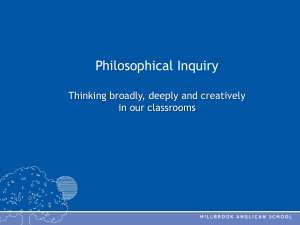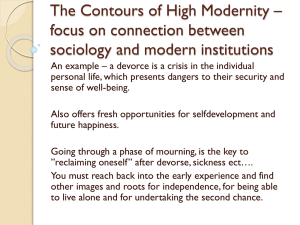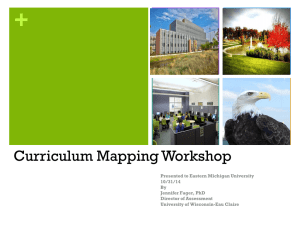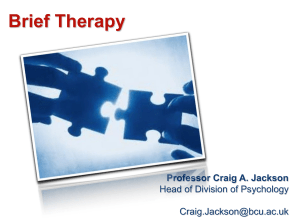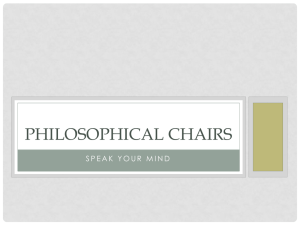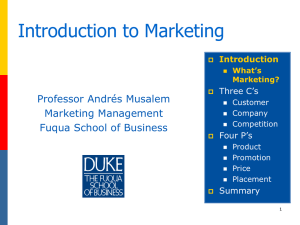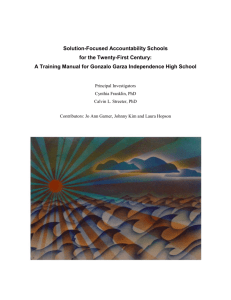Solution Focused-Pos.. - Northeastern Illinois University
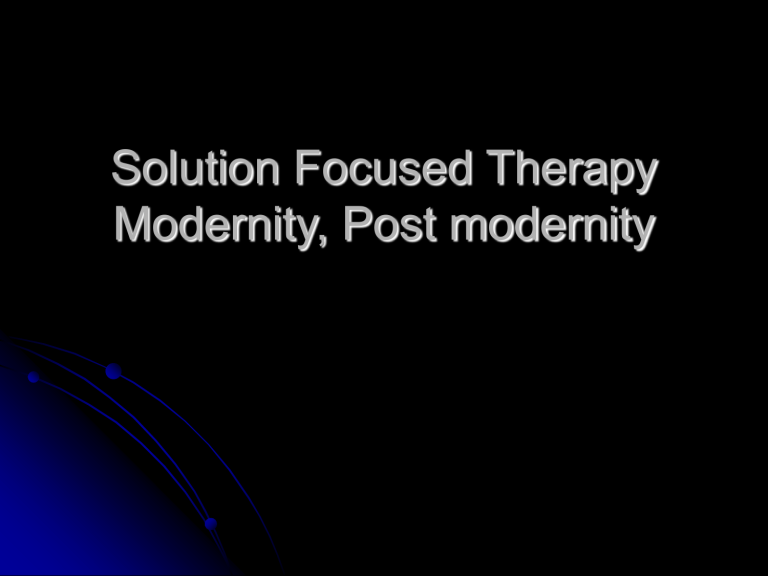
Solution Focused Therapy
Modernity, Post modernity
Types/ Models
Of Counseling/
Psychotherapy
Usage of Counseling/Psychotherapy Models
Illinois
N=584 n=186
31.84%
National
N=1660 n= 456
27.5%
Counsel
N=877 n=241
27.48%
Psych
N=437 n=94
21.51%
S.W.
N=346 n=119
34.39%
Adlerian
Behavioral
Brief Strategic
Client Centered
Cognitive
Family Systems
6
65
35
38
66
54
3
58
35
39
93
65
3
35
16
33
49
35
0
11
6
3
34
8
0
9
9
2
9
21
Jungian
Narrative
Psychodynamic
Reality
Solution Focused
1
9
34
23
82
1
3
58
27
82
0
0
10
24
51
1
2
25
0
4
0
1
24
3
25
Structural 5 3 1 0 2
Usage frequency of various models of counseling/psychotherapy as reported by Internship Sites, from Illinois Counseling, and by discipline in the USA*.
Data from COR Grant research from a State of Illinois Survey (1999-2000) and a National Survey (2000-01), by Dr. Jeffrey K. Edwards, Department of Counselor
Education, Northeastern Illinois University, Chicago, IL 60625.
* Most all sites also provide internship preparation for multi-disciplines.
An interesting story about a famous research scientist who had made several very important medical breakthroughs came about as he was being interviewed by a newspaper reporter who asked him why he thought he was able to be so much more creative than the average person. What set him so far apart from the others?
He responded that, in his opinion, it all came from an experience with his mother that occurred when he was about two years old. He had been trying to remove a bottle of milk from the refrigerator when he lost his grip on the slippery bottle and it fell, spilling its Contents all over the kitchen floor —a veritable sea of milk
When his mother came into the kitchen, instead of yelling at him, giving him a lecture, or punishing him, she said, “Robert, what a great and wonderful mess you have made! I have rarely seen such a huge puddle of milk. Well, the damage has already been done.
Would you like to get down and play in the milk for a few minutes before we clean it up?
Indeed, he did. After a few minutes, his mother said, You know
Robert, whenever you make a mess like this, eventually you have to clean it up and restore everything to its proper order. So, how would you like to do that? We could use a sponge, and towel or a mop.
Which do you prefer?” He chose the sponge and together they cleaned up the spilled milk.
Philosophical frameworks to ponder
Modernity -
Functionalism -
Structuralism -
Logical positivism –
Postmodernism –
Second Order Cybernetics -
Constructivism (radical and social)
Epistemology -
Philosophical frameworks to ponder
Modernity –
Modernity, which began intellectually with the Enlightenment, attempted to describe the world in rational, empirical and objective terms. It assumed that there was a truth to be uncovered, a way of obtaining answers to the question posed by the human condition.
Philosophical frameworks to ponder
Modernity -
Functionalism -
Functionalism is one of the major proposals that have been offered as solutions to the mind/body problem. Solutions to the mind/body problem usually try to answer questions such as:
What is the ultimate nature of the mental? That is, what makes a thought a thought? What makes a pain a pain?
Functionalism says that mental states are constituted by their causal relations to one another and to sensory inputs and behavioral outputs.
Functionalism is one of the major theoretical developments of
Twentieth Century analytic philosophy, and provides the conceptual underpinnings of much work in cognitive science.
Functionalists believe that the basis of an orderly society is the existence of a central value system that imposes common values on all its members.
Therefore, when
Functionalists look at the ways in which the various parts of society contribute to bringing about social order they are mainly concerned with the ways in which these parts help to perpetuate and maintain this common value system.
In architecture, functionalists believed that all that was required of buildings was that they do their job. Mies Van Der
Rohe
Philosophical frameworks to ponder
Modernity -
Structuralism –
In the 1960's, the structuralist movement, based in France, attempted to synthesize the ideas of Marx, Freud and Saussure. They disagreed with the existentialists' claim that each man is what he makes himself. For the structuralist the individual is shaped by sociological, psychological and linguistic structures over which he/she has no control, but which could be uncovered by using their methods of investigation.
Philosophical frameworks to ponder
Modernity -
Logical positivism –
Twentieth-century philosophical movement that used a strict principle of verifiability to reject as meaningless the non-empirical statements of metaphysics , theology, and ethics . Under the influence of Hume ,
Russell , and the early Wittgenstein , the logical positivists regarded as meaningful only statements reporting empirical observations, logic and mathematics.
Philosophical frameworks to ponder
Postmodernism
–
Second Order Cybernetics
Constructivism (radical and social)
Epistemology –
Narrative -
Philosophical frameworks to ponder
Postmodernism –
Post-structuralism and deconstruction can be seen as the theoretical formulations of the post-modern condition. Modernity, which began intellectually with the Enlightenment, attempted to describe the world in rational, empirical and objective terms. It assumed that there was a truth to be uncovered, a way of obtaining answers to the question posed by the human condition.
Post-modernism does not exhibit this confidence. The underlying certainties that reason promised are considered with skepticism, and reason is seen as a particular historical form, and truth is subject to scrutiny. The postmodern person has no rational way to evaluate a preference in relation to judgments of truth, morality, aesthetic experience or objectivity. As the old hierarchies of thought are torn down, a new clearing is formed on the frontiers of understanding.
Gone are truth and the need for hierarchical positioning.
Life and meaning can be deconstructed, and new meanings provided with equal validity.
Philosophical frameworks to ponder
Postmodernism
–
Second Order Cybernetics
All knowledge is based on what we have learned, not on truths.
Philosophical frameworks to ponder
Postmodernism
–
Constructivism (radical and social)
Philosophical frameworks to ponder
Postmodernism
–
Constructivism (radical and social)
Philosophical frameworks to ponder
Postmodernism
–
Epistemology –
The study of knowledge, or how we know what we know.
Philosophical frameworks to ponder
Postmodernism –
Narrative –
All of history as well as knowledge are made “true” by those who are in power, (not by all who are stakeholders) who put forth the knowledge. Concepts and knowledge are
“colonized” or “marginalized” by those doing the reporting and recording.
Our stories all have meaning, and through the telling and retelling (deconstructing) they change and create new meanings, The stories that have been told about us by others (family and other groups) maintain us in our positions and behaviors.
Getting the larger perspective
Imagine the Pacific Ocean, and Seal Island point off shore of San Diego. It is a habitat for all sorts of marine life, and harbor seals and walrus actually come here to play. It is fully ocean, and those who live there believe it to be ocean. Now back away from this and see the ocean, of which Seal Island is only a piece of the magnificent and larger piece of ocean.
Your understanding of life is like that! A piece of a larger, more magnificent and unknowable whole.
Solution-focused- Philosophy
Each individual has skills and resources to solve problems
Therapist’s task is to help clients identify resources
Solution-focused-Philosophy
Change is inevitable
Views of situations are what remains the same
Therapist’s task is to identify and amplify change
History is not important
Therapist’s task is to identify what is already working
Symptoms do not serve functions
Solution-focused-Philosophy
Small changes lead to additional changes
- Snowball effect
There is no single “valid” approach to a healthy lifestyle
Clients identify goals of treatment
Each person’s perspective is equally valid
Views on problems enhance or diminish problems
People create meanings from their experiences
Meaning limits alternatives
Solution-focused Source of motivation
Individuals must create and find meaning thru:
Languaging
Storying
Solution-focused Development of pathology
Focusing on negatives
Interpretation of experiences
Phenomenological experience
Prior solutions
Solution- focused Nature of change
Focus on positives
Focus on resources
Focus on strengths
Solution-focused Nature of change
Change the “doing” of the situation perceived as negative
Change the viewing of the situation
Evoke resources, solutions, and strengths of situation
Solution-focused Techniques
Use of language by:
“Normalizing” complaints
Re-creating meaning
Solution-focused Techniques
Solution Focused therapy (Cubs coach
Jim Fry and the movie )
Look for exceptions to the problem
Have them do more of what works
Miracle questions
Movie method and having them move into that behaviorally.
Solution Forced Therapy deShazar: the death of resistance.
Solution-focused Techniques
Joining- Use of client language, focus on chit chat
Exploration of “exceptions”
Solution-focused Techniques
Presupposition questions
So what brings you in?
When does “X” not occur?,
What is different about the times when ___?
How did you get that to happen?
How does it make your day go differently when ____(exception)?
Solution-focused Techniques
Who else noticed that _________?
How did you get her to stop _____?
How is it different from the way you might have handled it ________ ago?
What do you do for fun? What are your hobbies and interests?
Solution-focused Techniques
?
Have you ever had this difficulty in in the past? How did you resolve it then? What would you do to get that to happen again?
Solution-focused Techniques
Back to the future: Fast-forward questions
Miracle question
Are their small pieces of this that are already occurring?
How will your life be different?
Who will be the first to notice
Solution-focused Techniques
What will he/she do or say?
How will you respond?
Two exercises -
Solution oriented therapist and King of
Possibilities, Bill O”Hanlon suggests that you:
Recall a time or phase in your life when you felt free, flowing, alive, energetic, expansive, or resourceful.
Recreate the experience.
How did you feel in your body during that moment or those times?
What was your thinking like at that moment or those times?
How did you relate to others during that moment or those times?
O’Hanlon
What actions did you take that were different from your usual actions during that moment or those times?
Bring that sense to any situation in which you are having current difficulty or anticipate having difficulty in the future.
After recreating the experience, bring it to any current or future situation in which you have felt stuck, petty, selfish or frightened. Imagine in detail how you would feel in your body and what your thinking, actions, and ways of relating to others would be from that more expansive, spiritual place.
Berland
Next, Psychologist Warren Berland outlines a very simple solution oriented process that can help you rid yourself of problem focused thinking. He calls it getting “out of the box.”
Let’s try an abbreviated version of his technique so you might understand the power of solution work. Imagine a problem you are having.
Think about how this problem makes you feel and think about yourself. Are you hopeless, anxious, fearful, or self critical? Can you feel how this problem has you inside a box?
Berland
This box keeps out new information, and any hope of ever changing. It forces you to think only about the problem, and how you cannot get away from it. It makes you feel stuck and lose hope of ever having it change.
Can you feel the box closing in on you and restricting you? Your problem has put you inside a box.
Now imagine that you can cut a hole in the box, and look outside, even crawl out of it. As you crawl out of the box, you are able to look around you. What do you see?
What is your sense of being alive and how does your life look to you now? Notice how it feels to be totally free, and take a moment to experience this new freedom.
Berland
From this new perspective, you might feel a sense of well being, happiness, and confidence. Remember other time when you felt like this. Now, from this new position, how does your problem look?
Remember that, as you think about the problem and see how it changes for you.
For further information click on :
http://www.sfbta.org/index.html
